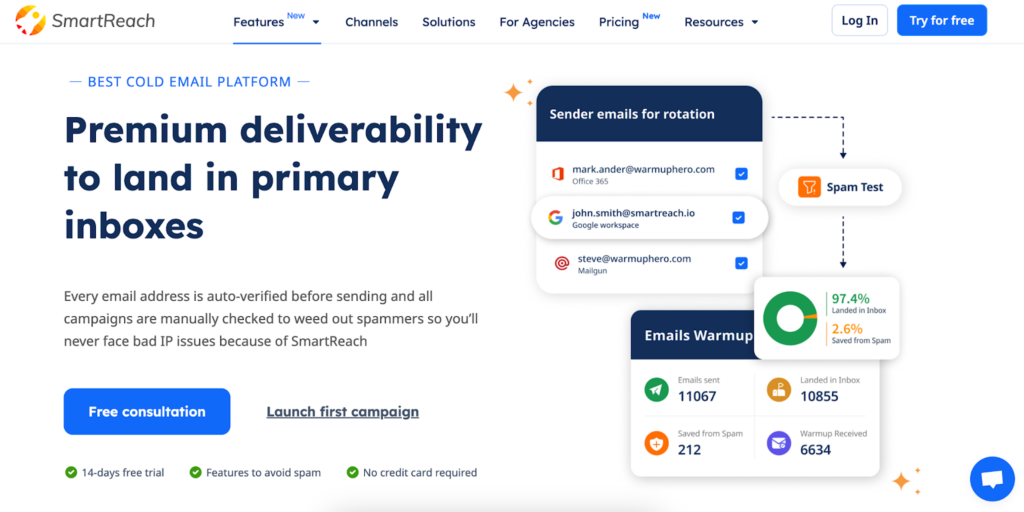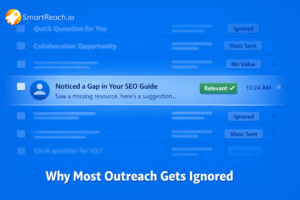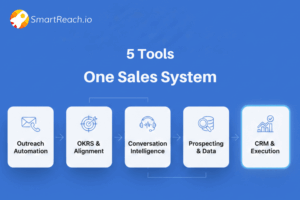How to Remove Emails from Blacklists | Sales Team Guide
One of our SmartReach customers panicked.
Three days before quarter-end, their entire outbound system flatlined. Twelve SDRs.
Zero replies. Zero meetings booked.
What went wrong?
One compromised email in their shared IP pool triggered Spamhaus, blacklisting their entire domain.
We see this happen more often than you’d think.
Email outbound teams lose thousands in the pipeline every week due to email blacklisting anywhere from $3,000 to $15,000, depending on team size and deal value.
For sales leaders managing territory-based teams, a single blacklisting incident can wreck your forecast and put entire quarters at risk.
This guide is your step-by-step playbook to fix it.
What are email blacklists and why sales teams get hit hard
Email blacklists are databases maintained by anti-spam organizations and email providers that flag IP addresses and domains for suspicious activity.
For outbound teams, this creates an immediate crisis.
When your prospect outreach gets blacklisted, you’re essentially cut off from your revenue pipeline.
Major email providers like Gmail, Outlook, and Yahoo either reject your emails entirely or route them to folders your prospects never check.
Why email IP & domains get blacklisted
The most common triggers for IP & domain blacklists include:
- Cold email volume spike: Scaling outreach too fast without warming up IPs or domains.
- Poor list hygiene: Sending to outdated, purchased, or scraped email lists that result in high bounces.
- Missing authentication: No or misconfigured SPF, DKIM, and DMARC records.
- Shared IP reputation: Others using the same IP might be sending spam, impacting your reputation.
- High spam complaints: Even a 0.3% complaint rate can flag your domain.
- Security Breach: Malware, hacked accounts, or unauthorized sending behavior.
For a complete details of blacklisting causes, read our detailed guide on why email gets blacklisted.
How to check if your email domains or IP addresses are blacklisted?
The first step in solving any blacklisting issue is confirming whether you’re actually on a blacklist and identifying which ones are affecting you.
Step-by-step guide using MX toolbox
MX Toolbox is the go-to tool for blacklist checks.
Here’s how to use it:
- Go to mxtoolbox.com → click on “Blacklist Check”

- Enter your IP or domain
- Not sure of your IP? Use their “What’s My IP?” tool
- Not sure of your IP? Use their “What’s My IP?” tool
- Run the scan
- It checks your IP/domain against 100+ major blacklists
- It checks your IP/domain against 100+ major blacklists
- Review results:
- Green checkmark = you’re clear ✅
- Red X = you’re blacklisted ❌
- Question mark = tool couldn’t verify (usually not critical)
- Green checkmark = you’re clear ✅
- Click any red X to:
- See which blacklist flagged you
- Understand the reason (if shared)
- Get a direct link to request removal
- See which blacklist flagged you
Other tools for checking email blacklists
- MultiRBL.valli.org – Scans 300+ blacklists, great for catching niche or regional ones.
- Gmail Postmaster Tools – Must-have for Gmail-heavy outreach. Shows spam rates, domain health, and sender reputation trends.
Early warning signs of domain blacklisting for email campaigns
- Sudden drop in open rates (especially <15%)
- Spike in bounce rates from Gmail, Outlook, Yahoo, etc.
- Test emails going straight to spam
- Warnings from your email service provider (ESP)

How to remove email blacklist in 5 easy steps?
If you’re blacklisted, don’t panic.
Here’s a structured plan to fix it fast.
Step 1 → Fix the root cause (Before you request removal)
Never rush to request delisting blacklist providers want to see that you’ve solved the actual problem.
Start by identifying and resolving these common issues:
- Fix email authentication (SPF, DKIM, DMARC)
- Clean your email lists – remove bounces, spam traps, and inactive contacts
- Update security – scan for malware, change passwords and remove unauthorized senders
- Improve sending practices – slow down volume, warm up inboxes & domains, segment lists
Step #2 → Document all the changes you have made
Keep a record of the corrective actions you’ve taken.
You’ll need this when submitting removal requests.
Include:
- DNS screenshots (SPF, DKIM, DMARC)
- Email list cleaning results
- Security scan reports
- Description of policy/process changes
Step #3: Prioritize which blacklists to tackle first
If you’re listed on multiple blacklists, don’t try to handle them all at once.
Focus on the ones that impact your sales pipeline the most.
| Priority | Blacklists | Why It Matters |
| 🔴 Critical | Spamhaus, Microsoft, Google | Impacts 80%+ of B2B outreach |
| 🟠 High | Barracuda, SpamCop | Impacts 15–20% of deliverability |
| 🟢 Monitor | Regional/niche blacklists | Limited exposure, track, but don’t panic |
Step 4: Submit removal requests (with evidence)
Here’s how to handle each major blacklist provider:
✅ Spamhaus (Most critical)
- Go to: spamhaus.org/lookup
- Search your IP/domain
- If listed, click the delisting link
- Submit an explanation of the issue + evidence of fixes
- Timeline: 24 hours to a few days
✅ Microsoft / Outlook
- Go to: sender.office.com
- Submit your IP + remediation details
- May ask for verification (especially if you’re a repeat offender)
- Timeline: 24 – 48 hours
✅ Barracuda
- Visit: barracudacentral.org/lookups
- Enter your IP, confirm listing
- Click “Request Removal”, include supporting info
- ⏱ Timeline: ~24 hours (faster for first-time offenses)
✅ SpamCop
- Most listings expire in 24 hours automatically
- For manual removal: Contact them via the site with evidence
- Timeline: Immediate (auto), 1–3 days (manual)
Step 5: Use a high-impact removal request template
Here’s a proven template to use:
| Subject: Blacklist Removal Request for [IP/Domain] Hi [Blacklist Provider], I am requesting removal of [IP/Domain] from your blacklist. The issue was caused by [briefly explain, e.g., a compromised email account or missing SPF record]. I’ve taken the following corrective actions: [Technical fix – e.g., “Configured SPF: v=spf1 include:_spf.google.com ~all”] [Security fix – e.g., “Scanned for malware and reset credentials”] [Process change – e.g., “Removed 2,847 outdated contacts from our list”] Supporting evidence is attached. We’ve also implemented ongoing monitoring to prevent recurrence. Thanks, [Your Name / Role / Contact Info] [Timeline – When issue started + when resolved] |
To increase your chances of approval, attach the following documents:
- Screenshots of updated DNS records (SPF, DKIM, DMARC)
- Security scan reports showing clean systems
- List cleaning reports (bounce removal, engagement metrics)
- Email authentication test results (from MXToolbox or your ESP)
How to prevent future email blacklists?
Here’s how to future-proof your email deliverability:
1. Set up proper email authentication
Authentication = trust. Without it, your emails look shady to ISPs.
- SPF (Sender Policy Framework)
- Authorizes which IPs can send on your domain’s behalf
- Add SPF record to DNS
- Use ~all (soft fail) or -all (hard fail) cautiously
- Authorizes which IPs can send on your domain’s behalf
- DKIM (DomainKeys Identified Mail)
- Adds a cryptographic signature to verify your emails
- Generate DKIM keys via ESP/email server
- Add the public key to DNS and test the signature
- Adds a cryptographic signature to verify your emails
- DMARC (Domain-based Message Authentication)
- Gives ISPs instructions when SPF/DKIM fail
- Start with p=none, move to p=quarantine, then p=reject
- Use DMARC reports to fine-tune without affecting legitimate emails
- Gives ISPs instructions when SPF/DKIM fail
Read more: How to set up SPF, DKIM & DMARC to keep emails out of spam?
2. Maintain clean, responsive email lists
Dirty email lists are blacklist magnets.
- Clean Regularly:
- Remove bounced emails immediately
- Purge inactive contacts at least every quarter
- Remove bounced emails immediately
- Segment Smartly:
- Focus on engaged audiences
- Avoid sending to unresponsive users repeatedly
- Focus on engaged audiences
- Manage Bounces:
- Automatically remove hard bounces
- Watch for soft bounce spikes (they signal trouble ahead)
- Automatically remove hard bounces
3. Manage sending volume strategically
Spam filters hate sudden spikes. Stay smooth and steady.
- Warm Up New IPs:
- Start small (50–100 emails/day)
- Scale slowly over 4–6 weeks
- Start small (50–100 emails/day)
- Keep a Consistent Schedule:
- Avoid irregular blasts
- Daily, consistent sending builds trust with ISPs
- Avoid irregular blasts
- Scale Gradually:
- No more than 50% increase per week
- Let reputation grow with volume
- No more than 50% increase per week
4. Monitor sender reputation weekly
Reputation issues usually show up in your metrics before you get blacklisted.
Track these KPIs weekly:
- Bounce Rate → Keep below 2%
- Spam Complaint Rate → Stay under 0.1%
- Unsubscribe Rate → Watch for sudden spikes
- Open/Click Rates → Drops can hint at filtering or blacklist risk
Get unlimited free blacklist monitoring with SmartReach.io
SmartReach is an AI-enabled sales engagement platform built for multichannel outreach while protecting email performance at every step.

The platform provides a premium email deliverability suite, which includes features like inbox rotation, ESP behavior matching, spam testing, and sender reputation tracking designed to maintain a strong sender score and maximize reach.
It also has a built-in free Global Blacklist Monitoring system that runs in the backend and alerts you when your email domains are affected.

SmartReach 24×7 monitors your domain and email accounts across major global blacklists like Spamhaus, Barracuda, and SpamCop.
If blacklisting is detected, it automatically pauses sending from affected email accounts to prevent further damage.
Early detection of email blacklists is critical.
Getting alerted the moment your domain is blacklisted gives you the chance to fix the issue, request delisting, and protect your sender’s reputation before it hurts your email deliverability more.
You’ll also see blacklist flags directly within your spam report, so your team has full visibility on what’s affecting deliverability, when, and where.
Try SmartReach.io free for 14 days.
Email blacklisiting: FAQs
1. How do you remove your IP or domain from a blacklist?
To remove your IP or domain from a blacklist, first, identify which blacklist has flagged you using tools like MXToolbox. Then, follow that blacklist provider’s specific removal process—usually involving a request form and proof of corrective actions, like fixing email authentication (SPF, DKIM, DMARC) or securing compromised accounts.
2. How do I remove a URL from the blacklist?
If your website URL is blacklisted (often for malware or phishing), use Google Search Console, Bing Webmaster Tools, or the relevant blacklist database to request a review. First, ensure all malicious code or vulnerabilities are removed. Once fixed, submit a reconsideration request with evidence of cleanup.
3. How to remove the IP address ban?
To remove an IP address ban, identify the blocking service (e.g., Spamhaus, Barracuda, Cloudflare). Fix the root cause (spammy behavior, missing DNS records, high bounce rates), then submit a delisting request on their platform. Monitor your sending practices to avoid future bans.
4. How to prevent IP blacklisting?
Prevent IP blacklisting by:
- Setting up SPF, DKIM, and DMARC correctly
- Avoiding spammy content and suspicious links
- Warming up new IPs slowly
- Cleaning email lists regularly to reduce bounces
- Monitoring domain/IP reputation weekly using tools like SmartReach or MXToolbox
5. How do I get my IP removed from blacklist?
Use a blacklist-checking tool to confirm the listing. Then visit the blacklist provider’s site, follow their removal steps, and include proof of fixes (updated DNS, authentication, list hygiene). Most providers respond within 24–72 hours if the issue is resolved.
6. What do I do if my domain is blacklisted?
If your domain is blacklisted, pause all email campaigns immediately. Identify the cause (e.g., spam complaints, hacked scripts, poor list hygiene), correct it, and submit a removal request to the blacklist provider. Use SmartReach’s Global Blacklist Monitoring for alerts and resolution tracking.
7. How can I remove myself from the blacklist?
To remove yourself from an email or IP blacklist:
- Identify the blacklist and reason for the listing
- Fix the root cause (spam behavior, security breaches)
- Submit a detailed removal request with proof of resolution
- Monitor your domain regularly to catch future issues early
8. How to get out of IP blacklist?
To get out of an IP blacklist, resolve the issue causing the listing (e.g., spam complaints, insecure servers), then request removal through the blacklist’s portal. Include your IP address, explain what was fixed, and share supporting documentation.
9. How to avoid blacklisting?
To avoid email blacklisting:
- Authenticate your domain with SPF, DKIM, and DMARC
- Maintain clean, verified email lists
- Avoid high-volume blasts from new or cold IPs
- Monitor spam complaints and bounce rates
- Use deliverability tools like SmartReach for proactive alerts and spam protection




